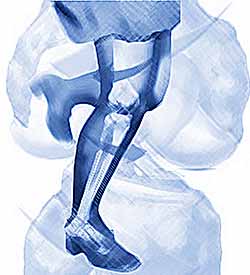| |
Knee
Injuries
Knee injuries are common in both sports
and car accidents. The parts
of the knee that can be damaged due to injury include bones, cartilage,
ligaments, tendons, and muscles. The
bones that come together to form the knee include the femur (upper
leg), tibia (lower leg) and patella ( knee cap).
Cartilage serves to pad the knee, helping
with wear and tear and preventing shock.
Tendons and ligaments connect the muscle tissue to the bones
of the knee plus interconnect the bones of the knee and may receive
strains and tears when injured. The muscles that connect to the
knee include the quadriceps muscle from the upper leg and the
hamstring muscles from the lower leg. These muscles may receive
tears and injuries as well.
The ligament most commonly injured is the anterior cruciate ligament
(ACL), which resides in the center of the knee joint. An ACL injury
is common in many sports and does not heal by itself so surgery
is required for reparation. Sudden twists to the knee, jumping
and hard running can damage the ACL. A torn ACL will bleed into
the knee and will cause swelling, pain and joint laxity.
Overstretched and overworked tendons can stretch, tear and bleed.
Most of the times, though, these injuries heal by themselves and
don't require surgery. Cartilage tears are also very common knee
injuries particularly to the meniscus, which is often torn or
split. Severe impact or twisting during weight lifting exercises,
can damage the meniscus. Swelling, pain and the inability to straighten
the leg are common signs of a meniscus tear.
Patello-femoral pain syndrome usually comes on gradually over
time and is characterized by a pain behind the knee cap. Wear
and tear to the patella is usually caused by abnormal movement
of the kneecap as the knee is bent and straightened.
The Better Health Channel offers this advice for attending to
knee injuries:
First
aid for knee injuries in the first 48 to 72 hours
Suggestions for first aid treatment of an injured knee include:
- Stop your activity immediately, rather than 'work through'
the pain..
- Rest the joint whenever possible.
- Reduce pain, swelling and internal bleeding with icepacks,
applied for 15 minutes every couple of hours.
- Bandage the knee firmly, and extend the wrapping down the
lower leg.
- Elevate the injured leg.
- Don't apply heat to the joint.
- Avoid alcohol, as this encourages bleeding and swelling.
- Don't massage the joint, as this encourages bleeding and swelling.
Some of the treatment options for moderate to severe knee injuries
include:
- Aspiration - if the knee joint is grossly swollen, the doctor
may release the pressure by drawing off some of the fluid with
a fine needle.
- Physiotherapy - including ultrasound and electrical muscle
stimulation treatment, kneecap taping, exercises for increased
mobility and strength, and associated rehabilitation techniques.
- Arthroscopic surgery - or 'keyhole' surgery, where the knee
operation is performed by inserting slender instruments through
small incisions. Cartilage tears are often treated with arthroscopic
surgery.
- Open surgery - required when the injuries are more severe.
The entire joint needs to be laid open for repair.
Quick action is generally advise when one receives a knee injury.
By getting professional help early, further damage can be avoided
and treatment options can be outlined and put into place. Waiting
to take care of a knee injury at a later time can result in deterioration
of the injury and a less positive outcome for future recovery.
|
|


